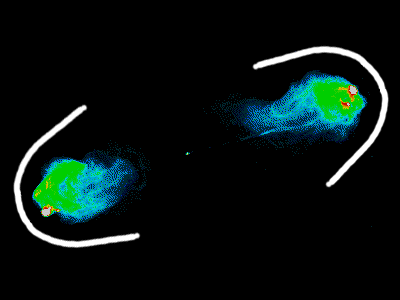Cosmic ray particles have been seen with staggeringly large energies of up to(100 billion billion) electron-volts, but Don Melrose, Colin Norman and Bram Achterberg take these events in their stride and have shown how such energies can plausibly be reached.
In the Universe at large, elementary particles such as protons are routinely accelerated to energies enormously greater than anything which can be achieved with current, or planned, man-made particle accelerators. For the most part these cosmic ray particles are thought to arise in strong shock waves (discontinuous pressure jumps) within our Galaxy, and in turn these shock waves arise during supernova explosions. But for the highest energies observed a different explanation must be sought as interstellar shock waves are simply too small to be able to generate such energies: the particles wander out of the acceleration zone long before they can attain the sort of energies observed.
Don Melrose, Colin Norman and Bram Achterberg (U. Utrecht) have established that these ultra-high energy particlescan be explained using the theory of shock acceleration, but applied to much larger shocks. Effective acceleration requires shocks larger than the typical sizes of galaxies, and these must be shocks in intergalactic space.
The highest energy cosmic rays are observed to be predominantly protons. Nuclei heavier than protons are more common amongst the lower-energy cosmic ray population than in the ultra-high energy cosmic rays. Existing ideas suggest that shock acceleration leads to an admixture of heavier nuclei that reflects the admixture present in the gas in the acceleration zone. Don, Colin and Bram deduce that to explain the defficiency in heavier nuclei in the highest energy cosmic rays, the regions where they are accelerated must be essentially free of heavy elements, thus reducing the variety of possible acceleration sites. The plausible locations include shocks permeating the large scale structures in the Universe - i.e. associations of clusters of galaxies, and structures on even larger scales - and shocks driven into extragalactic space by radio galaxies. In the latter case, jets of radio-emitting plasma flow from the nucleus of the galaxy to distances far greater than the size of the galaxy itself. At the termination of these flows we expect to find the large, strong shocks which are needed for ultra-high energy cosmic ray acceleration, and Don, Colin and Bram consider these objects to be the likeliest sources of the most energetic particles observed.

False-color image of the tiny central core and the lobes of emission produced by jets of material ejected from the core of the radio galaxy Cygnus A. The white spot in each lobe shows where the jet ends in a termination shock, sites where particles may be accelerated up to energies of ![]() eV. The white lines sketched on the image indicate the weaker bowshocks created
as material from the jets ploughs into the intergalactic medium, similar to a bow-wave in front of a moving boat.
eV. The white lines sketched on the image indicate the weaker bowshocks created
as material from the jets ploughs into the intergalactic medium, similar to a bow-wave in front of a moving boat.